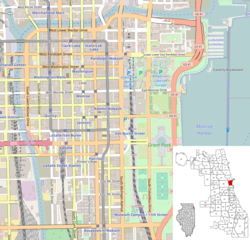Tower addition
In 1925, [9] the building was built to its current 35 story height by the addition of an adjacent tower to the east of the Madison street frontage. [7] The entire building contains 330,000 square feet (31,000 m2). [10] The 36-story tower was added east of the original structure on the site of the former DeSoto Building at 125-129 West Madison. [4] The tower was an early example of the use of setbacks and it uses ranks of paired windows. [7] When the Tower was built, four bronze bells were cast by the Meneely Bell Company (the second Meneely Bell Foundry) and installed as a clock-chime. They were set to chime an original composition called "Samheim", which is Norse for "Tomorrow", every quarter-hour. [11] The largest of these bells weighs 7,201 pounds (3,266 kg; 514.4 st) [12] and is inscribed with the name "Leander" in honor of Leander McCormick. [13] The current Roanoke building is the city's only example of a building in the style of Portuguese Gothic architecture. [14] According to the press release from the city announcing the landmark promotion, the building's terra cotta ornamentation is derived from Portuguese Gothic precedents. [3] The building was modernized in the 1950s and went through a postmodern renovation in 1984 to evoke the original ornamentation. [7] The building has the same frontage as the original Roanoke building plus that of the former Farewell Hall (built by William W. Boyington at 131-3 West Madison Street). [4]
From 1920 until 1969 the building hosted the offices of the law firm Sidley & Austin. [15] Today the building is leased by small service industry firms, such as second-floor tenant Thomas P. Gohagan & Co., which arranges travel trips and tours for non-profit organizations. [10]
The building is undergoing renovation to the lobby, the façade, the elevators and the exterior lighting. [10] The recent National Register listing has made the renovation feasible by making the building eligible for federal tax credits and reduced property taxes. [16] The building qualified for the landmark Class L tax status, [17] which makes it eligible for twelve years of reduced property taxes and other economic incentives for repair and rehab of historic buildings [18] In order to perform the renovation the owners took out a $43.3 million loan against the property according to Form 8-K filings with the U.S. Securities and Exchange Commission. [19] Its National Registered Historic Places announcement listed it under the name "Lumber Exchange Building and Tower Addition" although its Chicago Landmark listing is under the name "Roanoke Building and Tower." [1]
2015 Remodel
In October 2006, Michael Reschke bought the Roanoke building and he refinanced it in 2007. [20] In 2009, Reschke announced plans to convert the building into a high-end hotel. [21] In April 2012, Michael Silberberg-led Berkley Properties LLC appeared to have bought the Roanoke Building from KBS Capital Advisors LLC with plans to convert the building into a hotel. [22] However, financing difficulties caused the plans to be caught up in legal proceedings within a month. [23] By January 2014, Reschke had prevailed in a legal battle and secured financing for a $68 million construction loan to convert the building into a Residence Inn. [24] In late 2014, the city approved a $13.8 million, 12-year property tax incentive for rehabilitating historic elements of the building, adding a green roof, and converting the building to a Residence Inn. [25] On September 21, 2015, the building opened for business as the largest Residence Inn in the world with 380 rooms and 7500 square feet of meeting space after $136 million in renovations over two years. [26] On November 10, 2015, Residence Inn celebrated its 40th anniversary during the 100th year of the building's existence at this location, which was its 700th location. [27]


